Financial Accounting: Comprehensive Ratio Analysis of Tesco PLC
VerifiedAdded on 2023/06/18
|9
|2165
|205
Report
AI Summary
This report provides a comprehensive financial analysis of Tesco using ratio analysis and financial statement analysis. It evaluates the company's liquidity, profitability, efficiency, performance, and gearing ratios across several years (2017-2020). The analysis reveals that Tesco's liquidity position declined in 2018 and 2019 but improved in 2020. Profitability showed a positive trend in 2018 and 2019 but slowed down in 2020. Efficiency was moderate, with some ratios declining in 2020. The company's debt collection policy was effective, and its creditor repayment results were moderate. The gearing ratio indicated a high percentage of debt in the financial structure. The financial statement analysis showed a recovery from losses in 2017 to net profits in subsequent years, with a moderate downfall in 2020. Despite some limitations of accounting ratios, the overall financial performance of Tesco is evaluated as positive, with inclining share prices reflecting its profitability.

FINANCIAL ACCOUNTING
Paraphrase This Document
Need a fresh take? Get an instant paraphrase of this document with our AI Paraphraser
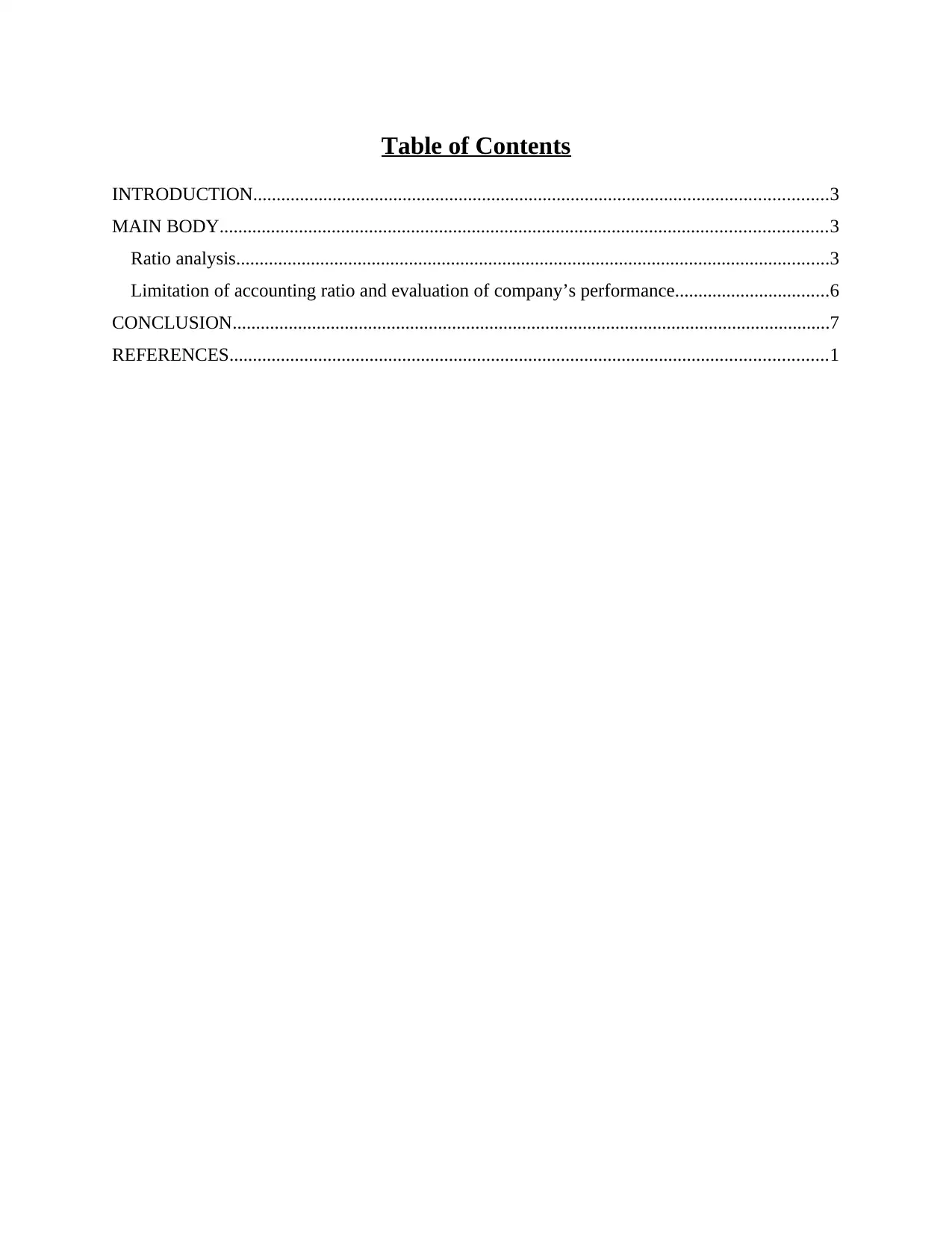
Table of Contents
INTRODUCTION...........................................................................................................................3
MAIN BODY..................................................................................................................................3
Ratio analysis...............................................................................................................................3
Limitation of accounting ratio and evaluation of company’s performance.................................6
CONCLUSION................................................................................................................................7
REFERENCES................................................................................................................................1
INTRODUCTION...........................................................................................................................3
MAIN BODY..................................................................................................................................3
Ratio analysis...............................................................................................................................3
Limitation of accounting ratio and evaluation of company’s performance.................................6
CONCLUSION................................................................................................................................7
REFERENCES................................................................................................................................1
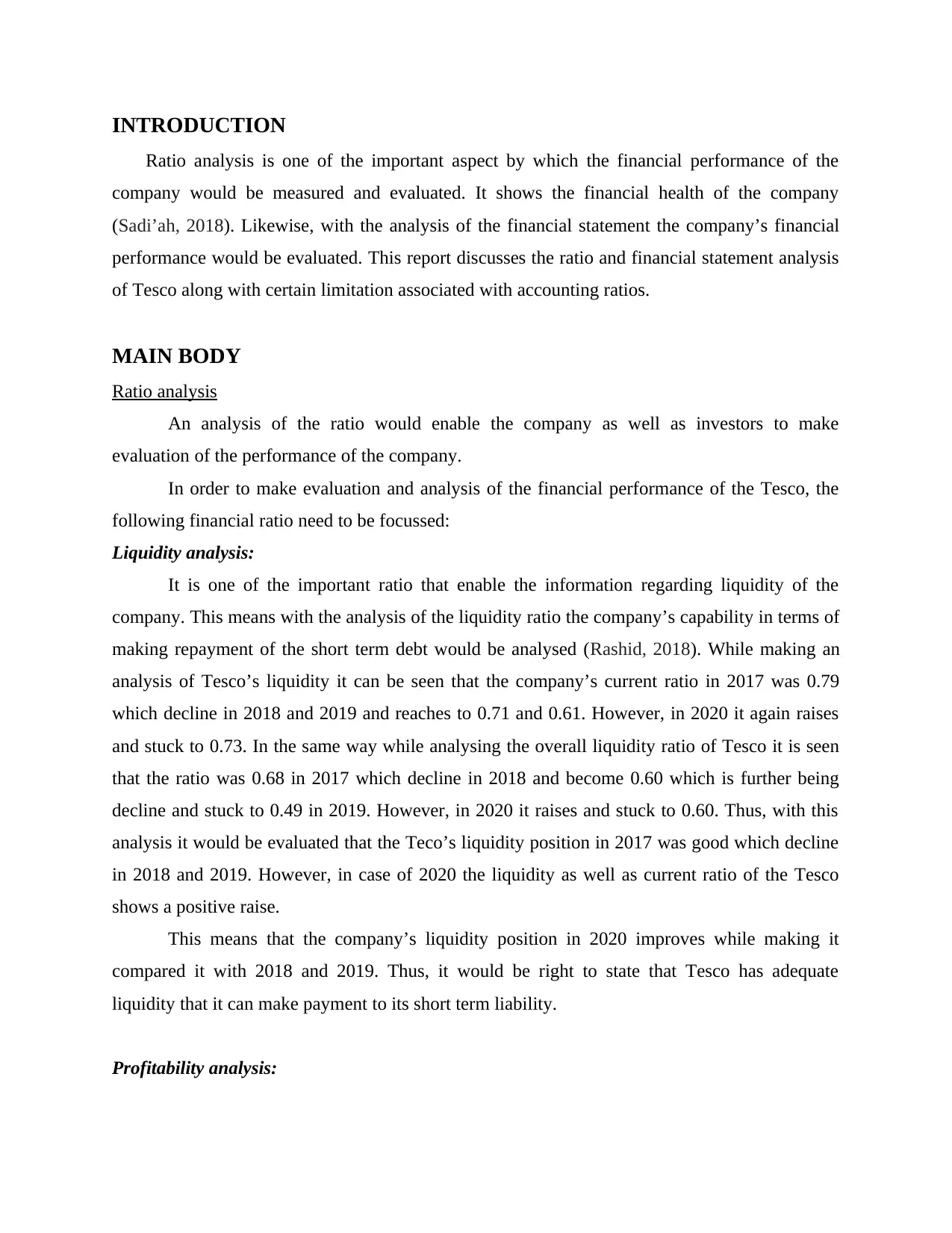
INTRODUCTION
Ratio analysis is one of the important aspect by which the financial performance of the
company would be measured and evaluated. It shows the financial health of the company
(Sadi’ah, 2018). Likewise, with the analysis of the financial statement the company’s financial
performance would be evaluated. This report discusses the ratio and financial statement analysis
of Tesco along with certain limitation associated with accounting ratios.
MAIN BODY
Ratio analysis
An analysis of the ratio would enable the company as well as investors to make
evaluation of the performance of the company.
In order to make evaluation and analysis of the financial performance of the Tesco, the
following financial ratio need to be focussed:
Liquidity analysis:
It is one of the important ratio that enable the information regarding liquidity of the
company. This means with the analysis of the liquidity ratio the company’s capability in terms of
making repayment of the short term debt would be analysed (Rashid, 2018). While making an
analysis of Tesco’s liquidity it can be seen that the company’s current ratio in 2017 was 0.79
which decline in 2018 and 2019 and reaches to 0.71 and 0.61. However, in 2020 it again raises
and stuck to 0.73. In the same way while analysing the overall liquidity ratio of Tesco it is seen
that the ratio was 0.68 in 2017 which decline in 2018 and become 0.60 which is further being
decline and stuck to 0.49 in 2019. However, in 2020 it raises and stuck to 0.60. Thus, with this
analysis it would be evaluated that the Teco’s liquidity position in 2017 was good which decline
in 2018 and 2019. However, in case of 2020 the liquidity as well as current ratio of the Tesco
shows a positive raise.
This means that the company’s liquidity position in 2020 improves while making it
compared it with 2018 and 2019. Thus, it would be right to state that Tesco has adequate
liquidity that it can make payment to its short term liability.
Profitability analysis:
Ratio analysis is one of the important aspect by which the financial performance of the
company would be measured and evaluated. It shows the financial health of the company
(Sadi’ah, 2018). Likewise, with the analysis of the financial statement the company’s financial
performance would be evaluated. This report discusses the ratio and financial statement analysis
of Tesco along with certain limitation associated with accounting ratios.
MAIN BODY
Ratio analysis
An analysis of the ratio would enable the company as well as investors to make
evaluation of the performance of the company.
In order to make evaluation and analysis of the financial performance of the Tesco, the
following financial ratio need to be focussed:
Liquidity analysis:
It is one of the important ratio that enable the information regarding liquidity of the
company. This means with the analysis of the liquidity ratio the company’s capability in terms of
making repayment of the short term debt would be analysed (Rashid, 2018). While making an
analysis of Tesco’s liquidity it can be seen that the company’s current ratio in 2017 was 0.79
which decline in 2018 and 2019 and reaches to 0.71 and 0.61. However, in 2020 it again raises
and stuck to 0.73. In the same way while analysing the overall liquidity ratio of Tesco it is seen
that the ratio was 0.68 in 2017 which decline in 2018 and become 0.60 which is further being
decline and stuck to 0.49 in 2019. However, in 2020 it raises and stuck to 0.60. Thus, with this
analysis it would be evaluated that the Teco’s liquidity position in 2017 was good which decline
in 2018 and 2019. However, in case of 2020 the liquidity as well as current ratio of the Tesco
shows a positive raise.
This means that the company’s liquidity position in 2020 improves while making it
compared it with 2018 and 2019. Thus, it would be right to state that Tesco has adequate
liquidity that it can make payment to its short term liability.
Profitability analysis:
⊘ This is a preview!⊘
Do you want full access?
Subscribe today to unlock all pages.

Trusted by 1+ million students worldwide
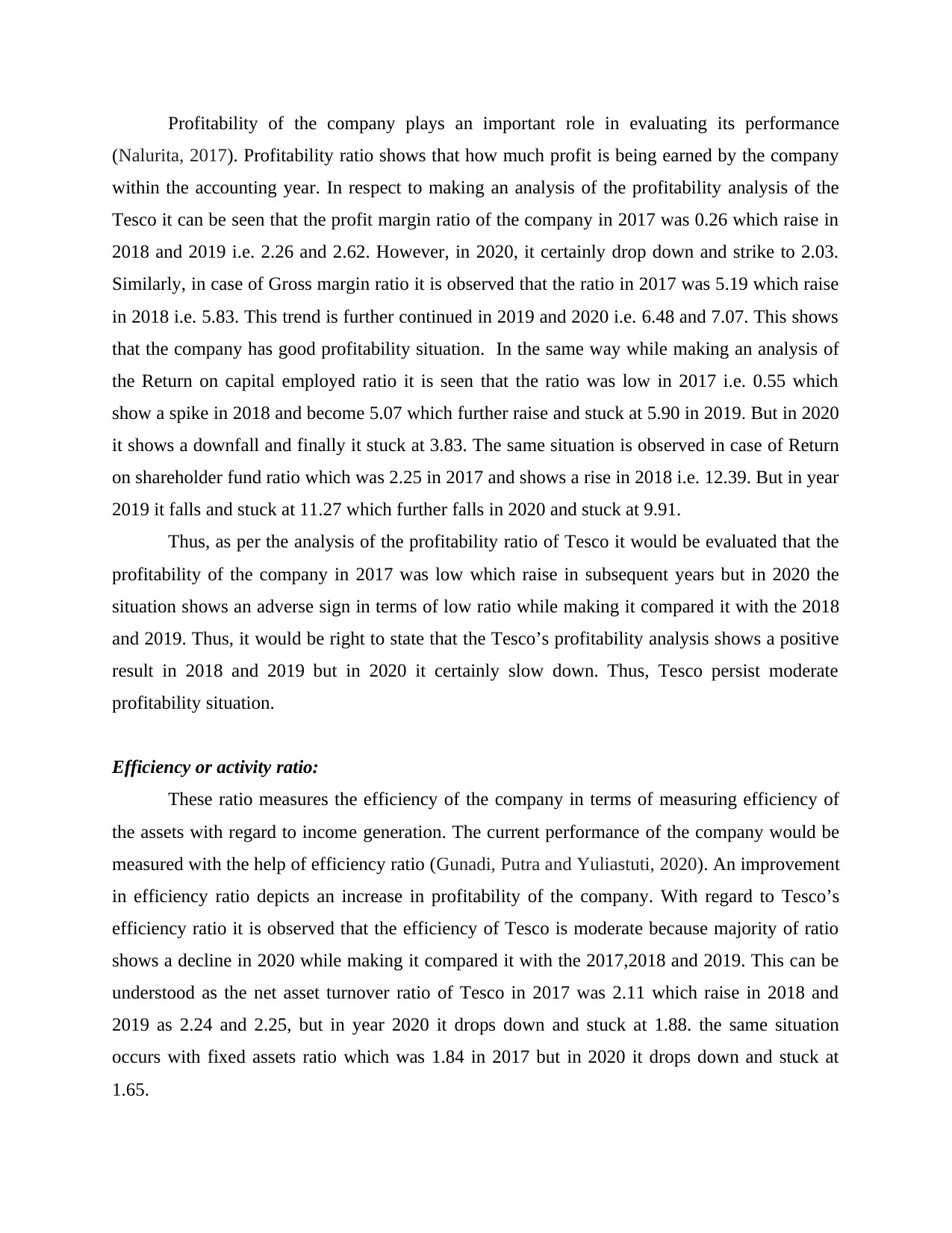
Profitability of the company plays an important role in evaluating its performance
(Nalurita, 2017). Profitability ratio shows that how much profit is being earned by the company
within the accounting year. In respect to making an analysis of the profitability analysis of the
Tesco it can be seen that the profit margin ratio of the company in 2017 was 0.26 which raise in
2018 and 2019 i.e. 2.26 and 2.62. However, in 2020, it certainly drop down and strike to 2.03.
Similarly, in case of Gross margin ratio it is observed that the ratio in 2017 was 5.19 which raise
in 2018 i.e. 5.83. This trend is further continued in 2019 and 2020 i.e. 6.48 and 7.07. This shows
that the company has good profitability situation. In the same way while making an analysis of
the Return on capital employed ratio it is seen that the ratio was low in 2017 i.e. 0.55 which
show a spike in 2018 and become 5.07 which further raise and stuck at 5.90 in 2019. But in 2020
it shows a downfall and finally it stuck at 3.83. The same situation is observed in case of Return
on shareholder fund ratio which was 2.25 in 2017 and shows a rise in 2018 i.e. 12.39. But in year
2019 it falls and stuck at 11.27 which further falls in 2020 and stuck at 9.91.
Thus, as per the analysis of the profitability ratio of Tesco it would be evaluated that the
profitability of the company in 2017 was low which raise in subsequent years but in 2020 the
situation shows an adverse sign in terms of low ratio while making it compared it with the 2018
and 2019. Thus, it would be right to state that the Tesco’s profitability analysis shows a positive
result in 2018 and 2019 but in 2020 it certainly slow down. Thus, Tesco persist moderate
profitability situation.
Efficiency or activity ratio:
These ratio measures the efficiency of the company in terms of measuring efficiency of
the assets with regard to income generation. The current performance of the company would be
measured with the help of efficiency ratio (Gunadi, Putra and Yuliastuti, 2020). An improvement
in efficiency ratio depicts an increase in profitability of the company. With regard to Tesco’s
efficiency ratio it is observed that the efficiency of Tesco is moderate because majority of ratio
shows a decline in 2020 while making it compared it with the 2017,2018 and 2019. This can be
understood as the net asset turnover ratio of Tesco in 2017 was 2.11 which raise in 2018 and
2019 as 2.24 and 2.25, but in year 2020 it drops down and stuck at 1.88. the same situation
occurs with fixed assets ratio which was 1.84 in 2017 but in 2020 it drops down and stuck at
1.65.
(Nalurita, 2017). Profitability ratio shows that how much profit is being earned by the company
within the accounting year. In respect to making an analysis of the profitability analysis of the
Tesco it can be seen that the profit margin ratio of the company in 2017 was 0.26 which raise in
2018 and 2019 i.e. 2.26 and 2.62. However, in 2020, it certainly drop down and strike to 2.03.
Similarly, in case of Gross margin ratio it is observed that the ratio in 2017 was 5.19 which raise
in 2018 i.e. 5.83. This trend is further continued in 2019 and 2020 i.e. 6.48 and 7.07. This shows
that the company has good profitability situation. In the same way while making an analysis of
the Return on capital employed ratio it is seen that the ratio was low in 2017 i.e. 0.55 which
show a spike in 2018 and become 5.07 which further raise and stuck at 5.90 in 2019. But in 2020
it shows a downfall and finally it stuck at 3.83. The same situation is observed in case of Return
on shareholder fund ratio which was 2.25 in 2017 and shows a rise in 2018 i.e. 12.39. But in year
2019 it falls and stuck at 11.27 which further falls in 2020 and stuck at 9.91.
Thus, as per the analysis of the profitability ratio of Tesco it would be evaluated that the
profitability of the company in 2017 was low which raise in subsequent years but in 2020 the
situation shows an adverse sign in terms of low ratio while making it compared it with the 2018
and 2019. Thus, it would be right to state that the Tesco’s profitability analysis shows a positive
result in 2018 and 2019 but in 2020 it certainly slow down. Thus, Tesco persist moderate
profitability situation.
Efficiency or activity ratio:
These ratio measures the efficiency of the company in terms of measuring efficiency of
the assets with regard to income generation. The current performance of the company would be
measured with the help of efficiency ratio (Gunadi, Putra and Yuliastuti, 2020). An improvement
in efficiency ratio depicts an increase in profitability of the company. With regard to Tesco’s
efficiency ratio it is observed that the efficiency of Tesco is moderate because majority of ratio
shows a decline in 2020 while making it compared it with the 2017,2018 and 2019. This can be
understood as the net asset turnover ratio of Tesco in 2017 was 2.11 which raise in 2018 and
2019 as 2.24 and 2.25, but in year 2020 it drops down and stuck at 1.88. the same situation
occurs with fixed assets ratio which was 1.84 in 2017 but in 2020 it drops down and stuck at
1.65.
Paraphrase This Document
Need a fresh take? Get an instant paraphrase of this document with our AI Paraphraser
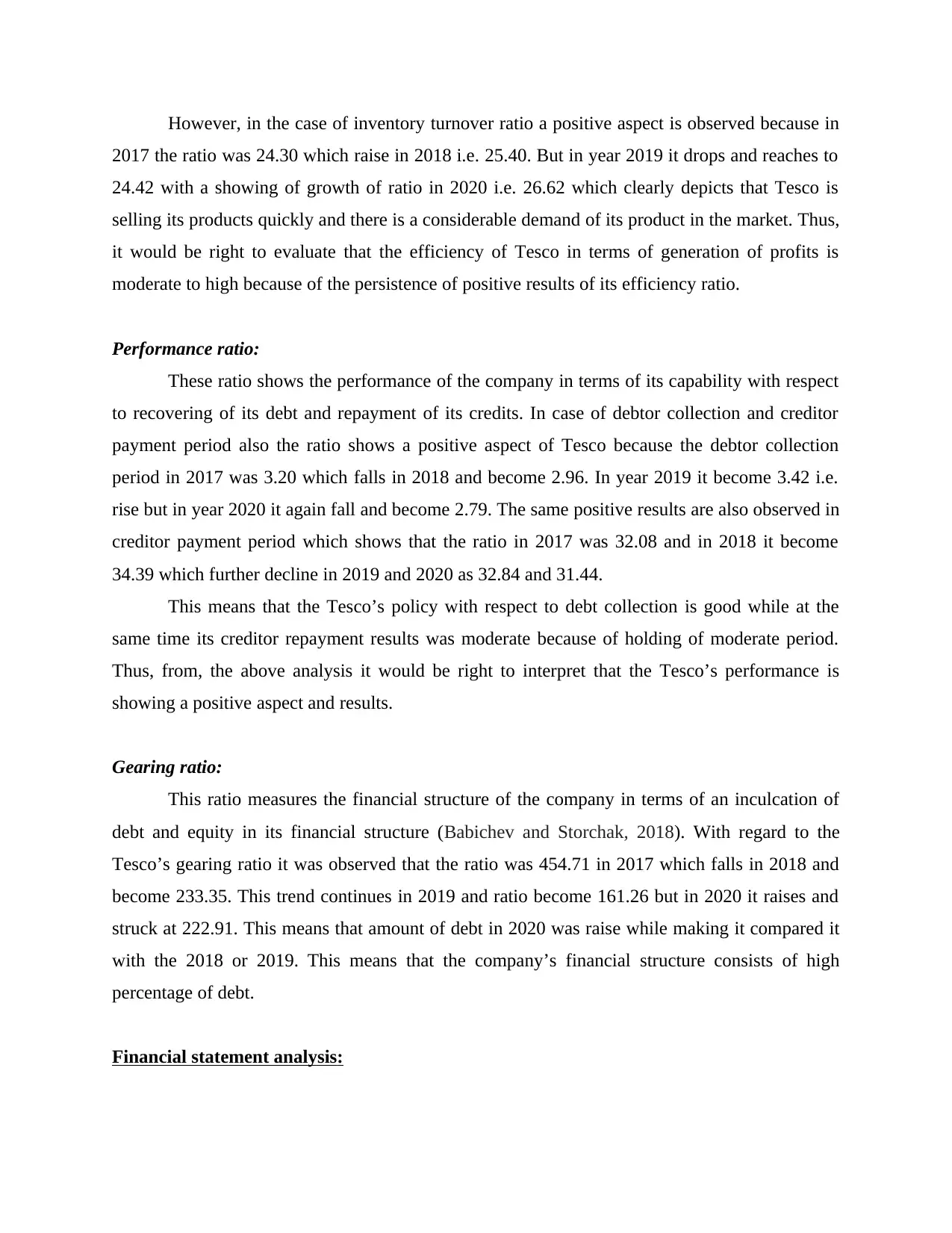
However, in the case of inventory turnover ratio a positive aspect is observed because in
2017 the ratio was 24.30 which raise in 2018 i.e. 25.40. But in year 2019 it drops and reaches to
24.42 with a showing of growth of ratio in 2020 i.e. 26.62 which clearly depicts that Tesco is
selling its products quickly and there is a considerable demand of its product in the market. Thus,
it would be right to evaluate that the efficiency of Tesco in terms of generation of profits is
moderate to high because of the persistence of positive results of its efficiency ratio.
Performance ratio:
These ratio shows the performance of the company in terms of its capability with respect
to recovering of its debt and repayment of its credits. In case of debtor collection and creditor
payment period also the ratio shows a positive aspect of Tesco because the debtor collection
period in 2017 was 3.20 which falls in 2018 and become 2.96. In year 2019 it become 3.42 i.e.
rise but in year 2020 it again fall and become 2.79. The same positive results are also observed in
creditor payment period which shows that the ratio in 2017 was 32.08 and in 2018 it become
34.39 which further decline in 2019 and 2020 as 32.84 and 31.44.
This means that the Tesco’s policy with respect to debt collection is good while at the
same time its creditor repayment results was moderate because of holding of moderate period.
Thus, from, the above analysis it would be right to interpret that the Tesco’s performance is
showing a positive aspect and results.
Gearing ratio:
This ratio measures the financial structure of the company in terms of an inculcation of
debt and equity in its financial structure (Babichev and Storchak, 2018). With regard to the
Tesco’s gearing ratio it was observed that the ratio was 454.71 in 2017 which falls in 2018 and
become 233.35. This trend continues in 2019 and ratio become 161.26 but in 2020 it raises and
struck at 222.91. This means that amount of debt in 2020 was raise while making it compared it
with the 2018 or 2019. This means that the company’s financial structure consists of high
percentage of debt.
Financial statement analysis:
2017 the ratio was 24.30 which raise in 2018 i.e. 25.40. But in year 2019 it drops and reaches to
24.42 with a showing of growth of ratio in 2020 i.e. 26.62 which clearly depicts that Tesco is
selling its products quickly and there is a considerable demand of its product in the market. Thus,
it would be right to evaluate that the efficiency of Tesco in terms of generation of profits is
moderate to high because of the persistence of positive results of its efficiency ratio.
Performance ratio:
These ratio shows the performance of the company in terms of its capability with respect
to recovering of its debt and repayment of its credits. In case of debtor collection and creditor
payment period also the ratio shows a positive aspect of Tesco because the debtor collection
period in 2017 was 3.20 which falls in 2018 and become 2.96. In year 2019 it become 3.42 i.e.
rise but in year 2020 it again fall and become 2.79. The same positive results are also observed in
creditor payment period which shows that the ratio in 2017 was 32.08 and in 2018 it become
34.39 which further decline in 2019 and 2020 as 32.84 and 31.44.
This means that the Tesco’s policy with respect to debt collection is good while at the
same time its creditor repayment results was moderate because of holding of moderate period.
Thus, from, the above analysis it would be right to interpret that the Tesco’s performance is
showing a positive aspect and results.
Gearing ratio:
This ratio measures the financial structure of the company in terms of an inculcation of
debt and equity in its financial structure (Babichev and Storchak, 2018). With regard to the
Tesco’s gearing ratio it was observed that the ratio was 454.71 in 2017 which falls in 2018 and
become 233.35. This trend continues in 2019 and ratio become 161.26 but in 2020 it raises and
struck at 222.91. This means that amount of debt in 2020 was raise while making it compared it
with the 2018 or 2019. This means that the company’s financial structure consists of high
percentage of debt.
Financial statement analysis:
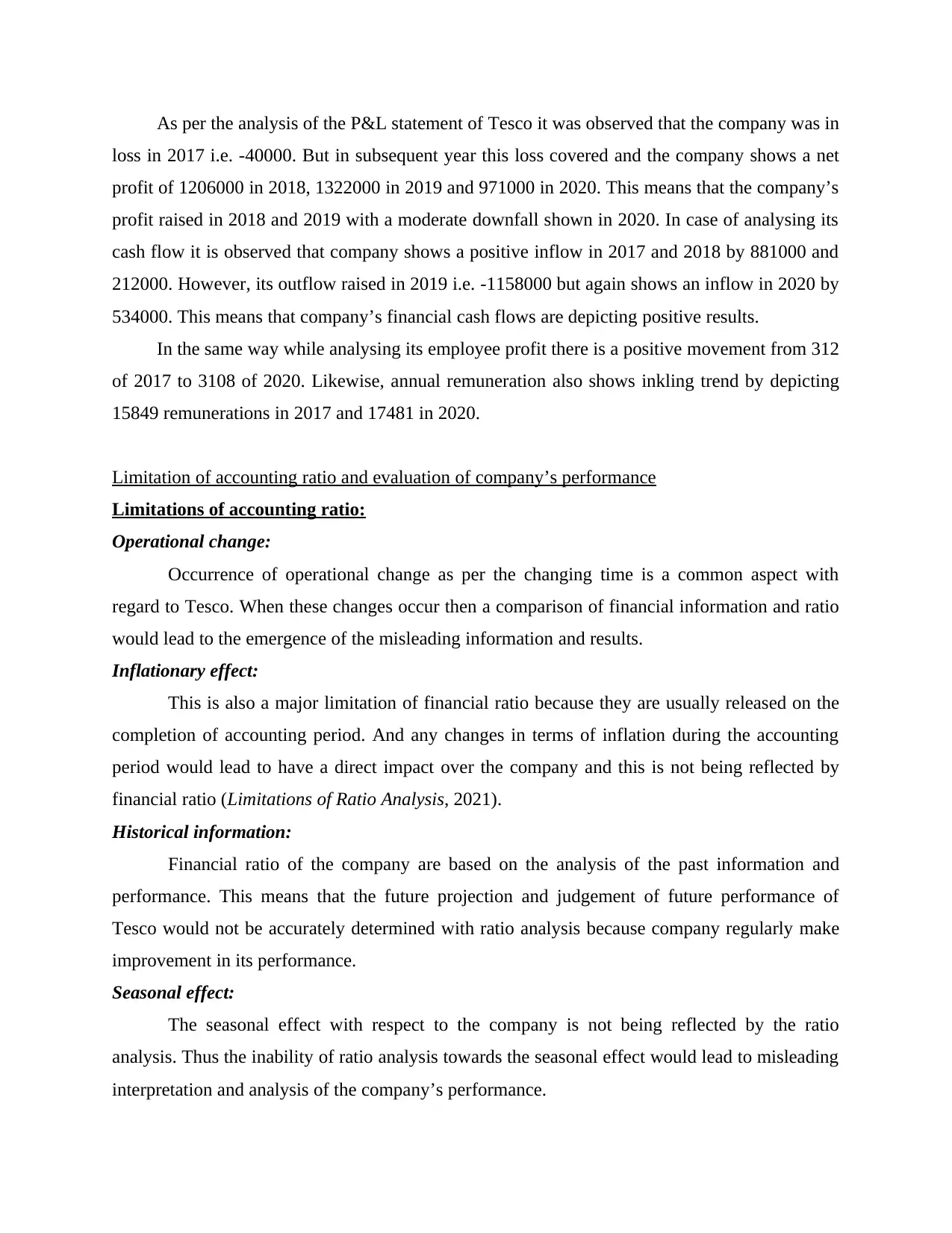
As per the analysis of the P&L statement of Tesco it was observed that the company was in
loss in 2017 i.e. -40000. But in subsequent year this loss covered and the company shows a net
profit of 1206000 in 2018, 1322000 in 2019 and 971000 in 2020. This means that the company’s
profit raised in 2018 and 2019 with a moderate downfall shown in 2020. In case of analysing its
cash flow it is observed that company shows a positive inflow in 2017 and 2018 by 881000 and
212000. However, its outflow raised in 2019 i.e. -1158000 but again shows an inflow in 2020 by
534000. This means that company’s financial cash flows are depicting positive results.
In the same way while analysing its employee profit there is a positive movement from 312
of 2017 to 3108 of 2020. Likewise, annual remuneration also shows inkling trend by depicting
15849 remunerations in 2017 and 17481 in 2020.
Limitation of accounting ratio and evaluation of company’s performance
Limitations of accounting ratio:
Operational change:
Occurrence of operational change as per the changing time is a common aspect with
regard to Tesco. When these changes occur then a comparison of financial information and ratio
would lead to the emergence of the misleading information and results.
Inflationary effect:
This is also a major limitation of financial ratio because they are usually released on the
completion of accounting period. And any changes in terms of inflation during the accounting
period would lead to have a direct impact over the company and this is not being reflected by
financial ratio (Limitations of Ratio Analysis, 2021).
Historical information:
Financial ratio of the company are based on the analysis of the past information and
performance. This means that the future projection and judgement of future performance of
Tesco would not be accurately determined with ratio analysis because company regularly make
improvement in its performance.
Seasonal effect:
The seasonal effect with respect to the company is not being reflected by the ratio
analysis. Thus the inability of ratio analysis towards the seasonal effect would lead to misleading
interpretation and analysis of the company’s performance.
loss in 2017 i.e. -40000. But in subsequent year this loss covered and the company shows a net
profit of 1206000 in 2018, 1322000 in 2019 and 971000 in 2020. This means that the company’s
profit raised in 2018 and 2019 with a moderate downfall shown in 2020. In case of analysing its
cash flow it is observed that company shows a positive inflow in 2017 and 2018 by 881000 and
212000. However, its outflow raised in 2019 i.e. -1158000 but again shows an inflow in 2020 by
534000. This means that company’s financial cash flows are depicting positive results.
In the same way while analysing its employee profit there is a positive movement from 312
of 2017 to 3108 of 2020. Likewise, annual remuneration also shows inkling trend by depicting
15849 remunerations in 2017 and 17481 in 2020.
Limitation of accounting ratio and evaluation of company’s performance
Limitations of accounting ratio:
Operational change:
Occurrence of operational change as per the changing time is a common aspect with
regard to Tesco. When these changes occur then a comparison of financial information and ratio
would lead to the emergence of the misleading information and results.
Inflationary effect:
This is also a major limitation of financial ratio because they are usually released on the
completion of accounting period. And any changes in terms of inflation during the accounting
period would lead to have a direct impact over the company and this is not being reflected by
financial ratio (Limitations of Ratio Analysis, 2021).
Historical information:
Financial ratio of the company are based on the analysis of the past information and
performance. This means that the future projection and judgement of future performance of
Tesco would not be accurately determined with ratio analysis because company regularly make
improvement in its performance.
Seasonal effect:
The seasonal effect with respect to the company is not being reflected by the ratio
analysis. Thus the inability of ratio analysis towards the seasonal effect would lead to misleading
interpretation and analysis of the company’s performance.
⊘ This is a preview!⊘
Do you want full access?
Subscribe today to unlock all pages.

Trusted by 1+ million students worldwide
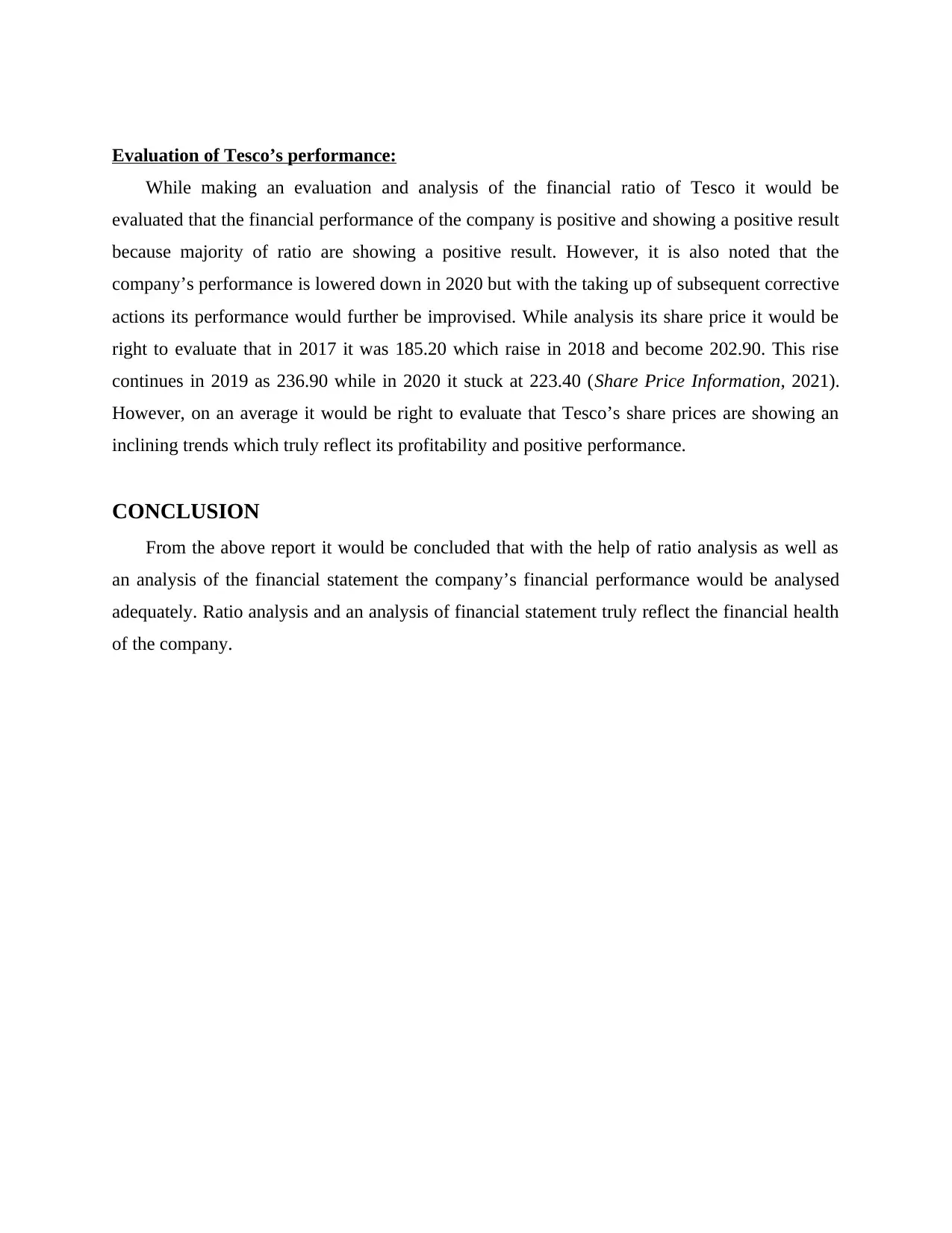
Evaluation of Tesco’s performance:
While making an evaluation and analysis of the financial ratio of Tesco it would be
evaluated that the financial performance of the company is positive and showing a positive result
because majority of ratio are showing a positive result. However, it is also noted that the
company’s performance is lowered down in 2020 but with the taking up of subsequent corrective
actions its performance would further be improvised. While analysis its share price it would be
right to evaluate that in 2017 it was 185.20 which raise in 2018 and become 202.90. This rise
continues in 2019 as 236.90 while in 2020 it stuck at 223.40 (Share Price Information, 2021).
However, on an average it would be right to evaluate that Tesco’s share prices are showing an
inclining trends which truly reflect its profitability and positive performance.
CONCLUSION
From the above report it would be concluded that with the help of ratio analysis as well as
an analysis of the financial statement the company’s financial performance would be analysed
adequately. Ratio analysis and an analysis of financial statement truly reflect the financial health
of the company.
While making an evaluation and analysis of the financial ratio of Tesco it would be
evaluated that the financial performance of the company is positive and showing a positive result
because majority of ratio are showing a positive result. However, it is also noted that the
company’s performance is lowered down in 2020 but with the taking up of subsequent corrective
actions its performance would further be improvised. While analysis its share price it would be
right to evaluate that in 2017 it was 185.20 which raise in 2018 and become 202.90. This rise
continues in 2019 as 236.90 while in 2020 it stuck at 223.40 (Share Price Information, 2021).
However, on an average it would be right to evaluate that Tesco’s share prices are showing an
inclining trends which truly reflect its profitability and positive performance.
CONCLUSION
From the above report it would be concluded that with the help of ratio analysis as well as
an analysis of the financial statement the company’s financial performance would be analysed
adequately. Ratio analysis and an analysis of financial statement truly reflect the financial health
of the company.
Paraphrase This Document
Need a fresh take? Get an instant paraphrase of this document with our AI Paraphraser
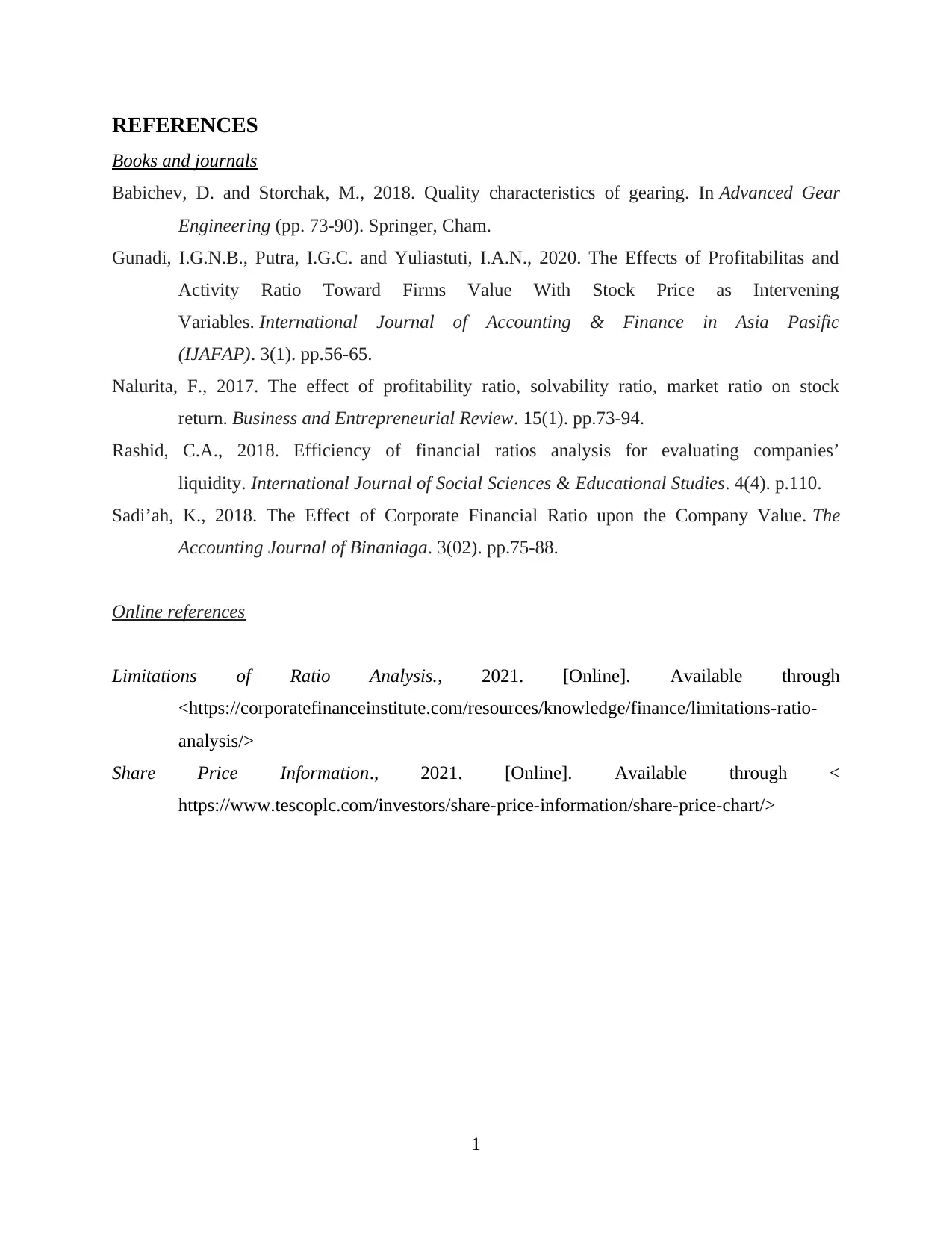
REFERENCES
Books and journals
Babichev, D. and Storchak, M., 2018. Quality characteristics of gearing. In Advanced Gear
Engineering (pp. 73-90). Springer, Cham.
Gunadi, I.G.N.B., Putra, I.G.C. and Yuliastuti, I.A.N., 2020. The Effects of Profitabilitas and
Activity Ratio Toward Firms Value With Stock Price as Intervening
Variables. International Journal of Accounting & Finance in Asia Pasific
(IJAFAP). 3(1). pp.56-65.
Nalurita, F., 2017. The effect of profitability ratio, solvability ratio, market ratio on stock
return. Business and Entrepreneurial Review. 15(1). pp.73-94.
Rashid, C.A., 2018. Efficiency of financial ratios analysis for evaluating companies’
liquidity. International Journal of Social Sciences & Educational Studies. 4(4). p.110.
Sadi’ah, K., 2018. The Effect of Corporate Financial Ratio upon the Company Value. The
Accounting Journal of Binaniaga. 3(02). pp.75-88.
Online references
Limitations of Ratio Analysis., 2021. [Online]. Available through
<https://corporatefinanceinstitute.com/resources/knowledge/finance/limitations-ratio-
analysis/>
Share Price Information., 2021. [Online]. Available through <
https://www.tescoplc.com/investors/share-price-information/share-price-chart/>
1
Books and journals
Babichev, D. and Storchak, M., 2018. Quality characteristics of gearing. In Advanced Gear
Engineering (pp. 73-90). Springer, Cham.
Gunadi, I.G.N.B., Putra, I.G.C. and Yuliastuti, I.A.N., 2020. The Effects of Profitabilitas and
Activity Ratio Toward Firms Value With Stock Price as Intervening
Variables. International Journal of Accounting & Finance in Asia Pasific
(IJAFAP). 3(1). pp.56-65.
Nalurita, F., 2017. The effect of profitability ratio, solvability ratio, market ratio on stock
return. Business and Entrepreneurial Review. 15(1). pp.73-94.
Rashid, C.A., 2018. Efficiency of financial ratios analysis for evaluating companies’
liquidity. International Journal of Social Sciences & Educational Studies. 4(4). p.110.
Sadi’ah, K., 2018. The Effect of Corporate Financial Ratio upon the Company Value. The
Accounting Journal of Binaniaga. 3(02). pp.75-88.
Online references
Limitations of Ratio Analysis., 2021. [Online]. Available through
<https://corporatefinanceinstitute.com/resources/knowledge/finance/limitations-ratio-
analysis/>
Share Price Information., 2021. [Online]. Available through <
https://www.tescoplc.com/investors/share-price-information/share-price-chart/>
1

2
⊘ This is a preview!⊘
Do you want full access?
Subscribe today to unlock all pages.

Trusted by 1+ million students worldwide
1 out of 9
Related Documents
Your All-in-One AI-Powered Toolkit for Academic Success.
+13062052269
info@desklib.com
Available 24*7 on WhatsApp / Email
![[object Object]](/_next/static/media/star-bottom.7253800d.svg)
Unlock your academic potential
Copyright © 2020–2025 A2Z Services. All Rights Reserved. Developed and managed by ZUCOL.




